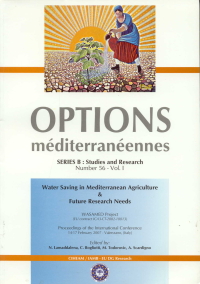| Article précédent | p. 213-221 | Article suivant |
Plant-soil water dynamics of alternative furrow and regulated deficit irrigation for two legume crops in the Fergana valley, Uzbekistan
The objective of this study was to evaluate the water use efficiency (WUE) and impact on components of the plant-soil water system of two water saving irrigation technologies used in food legume production in the Fergana Valley of Uzbekistan. Common bean and green gram, grown as second crops after winter wheat harvest, were irrigated using alternate furrow irrigation and regulated deficit irrigation. The WUE was quantified for commercial yield, above ground biomass and root biomass per unit of water consumed by the plant. WUE increased in green gram when deficit irrigation or alternate furrow irrigation were practiced, whereas it remained constant in bean for all treatment combinations. The use of both deficit irrigation and alternate furrow irrigation resulted in water savings and reduced crop evaporative consumption. The reduction was greater (46 percent) in green gram than common bean (23 percent) when the technologies were used together. Severely stressed bean was able to extract more water at 60 cm than non-stressed plants, whereas severely stressed green gram used less water at all depths. Collectively, these results indicate alternate furrow irrigation and deficit irrigation can increase WUE in the Fergana Valley, allowing application of less irrigation water, when used with appropriate crops.
L'objectif de cette recherche est d'évaluer l'efficacité de l'utilisation de l'eau (EUE) et l'impact de deux techniques d'irrigation, alternée et déficitaire, sur les composantes du système plante-sol, dans la production du haricot commun et mung, cultivés après la récolte de blé d'hiver, dans la vallée de Fergana, en Ouzbékistan. L'EUE a été calculée pour le rendement commercial, la biomasse en surface du sol et la biomasse racinaire par unité d'eau consommée par les plantes. L'EUE a augmenté pour le haricot mung en irrigation alternée et déficitaire mais elle est restée constante pour le haricot commun dans tous les traitements. L'utilisation d'une combinaison d'irrigation alternée et déficitaire a réduit la consommation d'eau et l'évaporation des cultures. Cette réduction a été plus importante pour le haricot mung (46 pour cent) que pour le haricot commun (23 pour cent) quand les deux techniques d'irrigation ont été utilisées ensemble. Le haricot commun sévèrement stressé est capable d'extraire plus d'eau à une profondeur de 60 cm comparé au traitement sans stress alors que le haricot mung a utilisé moins d'eau à toutes les profondeurs. Ces résultats démontrent que l'irrigation alternée et déficitaire peuvent augmenter l'EUE dans la vallée de Fergana, en réduisant la dose d'irrigation lorsque des cultures appropriées sont pratiquées.
- [ Afficher ]
- [ Télécharger ]
- [ Exporter la citation ]
Vous pouvez télécharger la citation au format :
- [ Imprimer ]
-
Mots-clés
DOSE D'IRRIGATION, EFFICACITE, IRRIGATION A LA RAIE, OUZBEKISTAN, PHASEOLUS VULGARIS, RELATION PLANTE SOL, UTILISATION DE L'EAU, VIGNA RADIATACiter cet article
Webber H., Madramootoo C., Bourgault M., Horst M., Stulina G., Smith D. Plant-soil water dynamics of alternative furrow and regulated deficit irrigation for two legume crops in the Fergana valley, Uzbekistan. In : Lamaddalena N. (ed.), Bogliotti C. (ed.), Todorovic M. (ed.), Scardigno A. (ed.). Water saving in Mediterranean agriculture and future research needs [Vol. 1]. Bari : CIHEAM, 2007. p. 213-221. (Options Méditerranéennes : Série B. Etudes et Recherches; n. 56 Vol.I). Proceedings of the International Conference WASAMED Project (EU contract ICA3-CT-2002-10013), 2007/02/14-17, Valenzano (Italy). http://om.ciheam.org/om/pdf/b56_1/00800114.pdf



